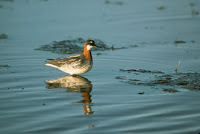RED-NECKED PHALAROPE
RED-NECKED PHALAROPE – (Phalaropus lobatus) – (See images below)
DESCRIPTION: The Red-necked Phalarope is a wading bird and part of the sandpiper family. Breeding females are mainly grey on top with a rusty breast and neck, a white throat and a dark face. As opposed to most birds, males are the ones with the duller colors, and they are also smaller. The species bill is long, thin and black, and the legs are grey. The toes are lobed. This bird is around 17 cm (7 inches) long.
VOICE: https://www.xeno-canto.org/species/Phalaropus-lobatus
NAME: The bird’s name (both English and Latin) ‘Phalarope’ comes from ancient Greek and refers to ‘Coot’ and ‘foot’. As with coots, phalaropes have lobed toes, which help them swim and walk on land with ease. ‘Lobatus’ refers to the same foot feature.
HABITAT: Red-necked phalaropes forage near the water surface and at the bottom of shallow water.
DIET: Fish, molluscs and crustaceans, plus insects during migration.
NESTING: Red-necked phalarope males do the incubating and the females do the courtship. The nest is a scrape on the ground. Generally three green-beige eggs are laid, and the young are able to feed themselves soon after birth.
DISTRIBUTION: Its breeding range encompasses the circumpolar arctic regions including Iceland. Its wintering range covers the coasts of the southern hemisphere continents. Some individuals have reached the islands of Hawaii as vagrants. (See note below on bird vagrancy.)
Distribution map: https://en.wikipedia.org/wiki/Red-necked_phalarope#/media/File:Phalaropus_lobatus_distribution.png
ON PEI: The red-necked phalarope does not breed on PEI. Sightings ooccur during the bird’s migration, i.e. mainly in the fall, sometimes in the spring.
CONSERVATION: The red-necked phalarope is considered as ‘least concern’ by the IUCN, but it is listed as ‘special concern’ by COSEWIC, as of 2014. Some of the reasons mentioned for the latter classification are a population decline in some areas of Canada, climate change as well as water pollution in the species breeding areas.
NOTES: Although a shorebird, red-necked phalarope can also swim thanks to its lobed toes.
Vagrancy: In biology this means an animal going way outside its normal range. For birds, this can happen when there are storms and they get blown off course. On other times, the bird simply wanders in a different direction than usual. Here’s an article about vagrancy in birds.
SIMILAR SPECIES: Red Phalarope, Wilson’s Phalarope
REFERENCES: https://www.borealbirds.org/bird/red-necked-phalarope
https://www.nwtspeciesatrisk.ca/species/red-necked-phalarope (Government of the Northwest Territory)
https://www.rspb.org.uk/birds-and-wildlife/wildlife-guides/bird-a-z/red-necked-phalarope (Royal Society for the Protection of Birds)
http://www.npolar.no/en/species/red-necked-phalarope.html (Norwegian Polar Institute)
http://www.oiseaux-birds.com/card-red-necked-phalarope.html
https://en.wikipedia.org/wiki/Red-necked_phalarope
https://www.audubon.org/field-guide/bird/red-necked-phalarope
DESCRIPTION: The Red-necked Phalarope is a wading bird and part of the sandpiper family. Breeding females are mainly grey on top with a rusty breast and neck, a white throat and a dark face. As opposed to most birds, males are the ones with the duller colors, and they are also smaller. The species bill is long, thin and black, and the legs are grey. The toes are lobed. This bird is around 17 cm (7 inches) long.
VOICE: https://www.xeno-canto.org/species/Phalaropus-lobatus
NAME: The bird’s name (both English and Latin) ‘Phalarope’ comes from ancient Greek and refers to ‘Coot’ and ‘foot’. As with coots, phalaropes have lobed toes, which help them swim and walk on land with ease. ‘Lobatus’ refers to the same foot feature.
HABITAT: Red-necked phalaropes forage near the water surface and at the bottom of shallow water.
DIET: Fish, molluscs and crustaceans, plus insects during migration.
NESTING: Red-necked phalarope males do the incubating and the females do the courtship. The nest is a scrape on the ground. Generally three green-beige eggs are laid, and the young are able to feed themselves soon after birth.
DISTRIBUTION: Its breeding range encompasses the circumpolar arctic regions including Iceland. Its wintering range covers the coasts of the southern hemisphere continents. Some individuals have reached the islands of Hawaii as vagrants. (See note below on bird vagrancy.)
Distribution map: https://en.wikipedia.org/wiki/Red-necked_phalarope#/media/File:Phalaropus_lobatus_distribution.png
ON PEI: The red-necked phalarope does not breed on PEI. Sightings ooccur during the bird’s migration, i.e. mainly in the fall, sometimes in the spring.
CONSERVATION: The red-necked phalarope is considered as ‘least concern’ by the IUCN, but it is listed as ‘special concern’ by COSEWIC, as of 2014. Some of the reasons mentioned for the latter classification are a population decline in some areas of Canada, climate change as well as water pollution in the species breeding areas.
NOTES: Although a shorebird, red-necked phalarope can also swim thanks to its lobed toes.
Vagrancy: In biology this means an animal going way outside its normal range. For birds, this can happen when there are storms and they get blown off course. On other times, the bird simply wanders in a different direction than usual. Here’s an article about vagrancy in birds.
SIMILAR SPECIES: Red Phalarope, Wilson’s Phalarope
REFERENCES: https://www.borealbirds.org/bird/red-necked-phalarope
https://www.nwtspeciesatrisk.ca/species/red-necked-phalarope (Government of the Northwest Territory)
https://www.rspb.org.uk/birds-and-wildlife/wildlife-guides/bird-a-z/red-necked-phalarope (Royal Society for the Protection of Birds)
http://www.npolar.no/en/species/red-necked-phalarope.html (Norwegian Polar Institute)
http://www.oiseaux-birds.com/card-red-necked-phalarope.html
https://en.wikipedia.org/wiki/Red-necked_phalarope
https://www.audubon.org/field-guide/bird/red-necked-phalarope
 |
| Red-necked phalarope, Donald Menke |
 |
| Red-necked phalarope, Roberta Palmer |